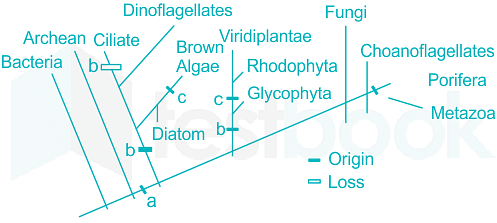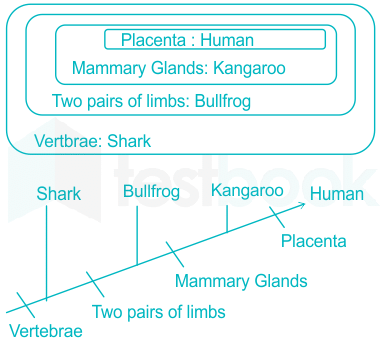Software Development Exam > Software Development Questions > Identify a, b and c in the figure; a)a =mitoc...
Start Learning for Free
Identify a, b and c in the figure;


- a)a =mitochondria; b = multicellularity; c = chloroplast
- b)a = mitochondria; b = chloroplast; c = multicellularity
- c)a = chloroplast; b = multicellularity; c = mitochondria
- d)a = chloroplast; b = nucleus; c = multicellularity
Correct answer is option 'B'. Can you explain this answer?
Verified Answer
Identify a, b and c in the figure; a)a =mitochondria; b = multicellula...
Concept:
- Diagrams called cladograms show the links between several taxonomic groups known as clades.
- Cladograms reconstruct the taxa's evolutionary history (phylogeny) by showing these links.
- Phylogenies and trees are other names for cladograms.
Fig 1: Example how a cladogram can be constructed


- Current versions of endosymbiotic theory state that archaeon (an archaebacterium) was the host and not a eukaryote.
- Hence the evolutionary history and biology of archaea increasingly comes to bear on eukaryotic origins, more than ever before.
- Bacteria and Archaea do not have mitochondria but Anaerobic ciliates on the other hand are incapable of using oxidative phosphorylation in their energy metabolism and they are more or less sensitive to oxygen.
- But all anaerobic ciliates possess mitochondria-like organelles (with a double outer membrane and often a few cristae) but these do not contain typical mitochondrial enzymes (e.g., cytochromes, cytochrome oxidase).
- Brown algae are exclusively multicellular and found in marine habitats, most typically in the intertidal zone but Diatoms are exclusively unicellular and found in almost every habitat where there is water, thus the feature multicellularity connects them.
- Their single cell is surrounded by a silica frustule composed of two distinct valves. They store their carbohydrates as chrysolaminarin.
- Most protozoologists believe that the ciliates arose from a flagellate.
- The flagellates that are most similar in structure to the ciliates are the dinoflagellates and two genera of uncertain taxonomic position, Colponema and Katablepharis.
- Structurally, dinoflagellates have a number of similarities with ciliates.
- The flagellates and the ciliates have long been considered to be closely related because of their unicellular nature and the similarity in the structures of the axoneme of the flagella and cilia in both groups.
- While ciliates do not have the innate ability to photosynthesize, some can sequester and utilize sequestered chloroplasts from their prey, a mechanism known as kleptoplasty.
- But Dinoflagellates are unicellular flagellated algae and their cells contain chlorophylls a and c thus Dinoflagellates to ciliates occured due to loss of chloroplasts.
- The members of the phylum Rhodophyta include mainly marine multicellular species, while freshwater or unicellular species are rare whereasGlycophytes are multicellular organisms comprising more than one cell, thus glycophytes evolved with multicellularity.
- A group of single-celled protists called choanoflagellates are the closest living relatives of animals.
- Choanoflagellate cells have a whip-like flagellum surrounded by a basket-like structure that they use to capture and eat bacteria floating in sea water whereas Poriferans are pore-bearing first multicellular animals.
hence the correct answer is option 1

|
Explore Courses for Software Development exam
|

|
Similar Software Development Doubts
Identify a, b and c in the figure; a)a =mitochondria; b = multicellularity; c = chloroplastb)a = mitochondria; b = chloroplast; c = multicellularityc)a = chloroplast; b = multicellularity; c = mitochondriad)a = chloroplast; b = nucleus; c = multicellularityCorrect answer is option 'B'. Can you explain this answer?
Question Description
Identify a, b and c in the figure; a)a =mitochondria; b = multicellularity; c = chloroplastb)a = mitochondria; b = chloroplast; c = multicellularityc)a = chloroplast; b = multicellularity; c = mitochondriad)a = chloroplast; b = nucleus; c = multicellularityCorrect answer is option 'B'. Can you explain this answer? for Software Development 2025 is part of Software Development preparation. The Question and answers have been prepared according to the Software Development exam syllabus. Information about Identify a, b and c in the figure; a)a =mitochondria; b = multicellularity; c = chloroplastb)a = mitochondria; b = chloroplast; c = multicellularityc)a = chloroplast; b = multicellularity; c = mitochondriad)a = chloroplast; b = nucleus; c = multicellularityCorrect answer is option 'B'. Can you explain this answer? covers all topics & solutions for Software Development 2025 Exam. Find important definitions, questions, meanings, examples, exercises and tests below for Identify a, b and c in the figure; a)a =mitochondria; b = multicellularity; c = chloroplastb)a = mitochondria; b = chloroplast; c = multicellularityc)a = chloroplast; b = multicellularity; c = mitochondriad)a = chloroplast; b = nucleus; c = multicellularityCorrect answer is option 'B'. Can you explain this answer?.
Identify a, b and c in the figure; a)a =mitochondria; b = multicellularity; c = chloroplastb)a = mitochondria; b = chloroplast; c = multicellularityc)a = chloroplast; b = multicellularity; c = mitochondriad)a = chloroplast; b = nucleus; c = multicellularityCorrect answer is option 'B'. Can you explain this answer? for Software Development 2025 is part of Software Development preparation. The Question and answers have been prepared according to the Software Development exam syllabus. Information about Identify a, b and c in the figure; a)a =mitochondria; b = multicellularity; c = chloroplastb)a = mitochondria; b = chloroplast; c = multicellularityc)a = chloroplast; b = multicellularity; c = mitochondriad)a = chloroplast; b = nucleus; c = multicellularityCorrect answer is option 'B'. Can you explain this answer? covers all topics & solutions for Software Development 2025 Exam. Find important definitions, questions, meanings, examples, exercises and tests below for Identify a, b and c in the figure; a)a =mitochondria; b = multicellularity; c = chloroplastb)a = mitochondria; b = chloroplast; c = multicellularityc)a = chloroplast; b = multicellularity; c = mitochondriad)a = chloroplast; b = nucleus; c = multicellularityCorrect answer is option 'B'. Can you explain this answer?.
Solutions for Identify a, b and c in the figure; a)a =mitochondria; b = multicellularity; c = chloroplastb)a = mitochondria; b = chloroplast; c = multicellularityc)a = chloroplast; b = multicellularity; c = mitochondriad)a = chloroplast; b = nucleus; c = multicellularityCorrect answer is option 'B'. Can you explain this answer? in English & in Hindi are available as part of our courses for Software Development.
Download more important topics, notes, lectures and mock test series for Software Development Exam by signing up for free.
Here you can find the meaning of Identify a, b and c in the figure; a)a =mitochondria; b = multicellularity; c = chloroplastb)a = mitochondria; b = chloroplast; c = multicellularityc)a = chloroplast; b = multicellularity; c = mitochondriad)a = chloroplast; b = nucleus; c = multicellularityCorrect answer is option 'B'. Can you explain this answer? defined & explained in the simplest way possible. Besides giving the explanation of
Identify a, b and c in the figure; a)a =mitochondria; b = multicellularity; c = chloroplastb)a = mitochondria; b = chloroplast; c = multicellularityc)a = chloroplast; b = multicellularity; c = mitochondriad)a = chloroplast; b = nucleus; c = multicellularityCorrect answer is option 'B'. Can you explain this answer?, a detailed solution for Identify a, b and c in the figure; a)a =mitochondria; b = multicellularity; c = chloroplastb)a = mitochondria; b = chloroplast; c = multicellularityc)a = chloroplast; b = multicellularity; c = mitochondriad)a = chloroplast; b = nucleus; c = multicellularityCorrect answer is option 'B'. Can you explain this answer? has been provided alongside types of Identify a, b and c in the figure; a)a =mitochondria; b = multicellularity; c = chloroplastb)a = mitochondria; b = chloroplast; c = multicellularityc)a = chloroplast; b = multicellularity; c = mitochondriad)a = chloroplast; b = nucleus; c = multicellularityCorrect answer is option 'B'. Can you explain this answer? theory, EduRev gives you an
ample number of questions to practice Identify a, b and c in the figure; a)a =mitochondria; b = multicellularity; c = chloroplastb)a = mitochondria; b = chloroplast; c = multicellularityc)a = chloroplast; b = multicellularity; c = mitochondriad)a = chloroplast; b = nucleus; c = multicellularityCorrect answer is option 'B'. Can you explain this answer? tests, examples and also practice Software Development tests.

|
Explore Courses for Software Development exam
|

|
Signup for Free!
Signup to see your scores go up within 7 days! Learn & Practice with 1000+ FREE Notes, Videos & Tests.
























